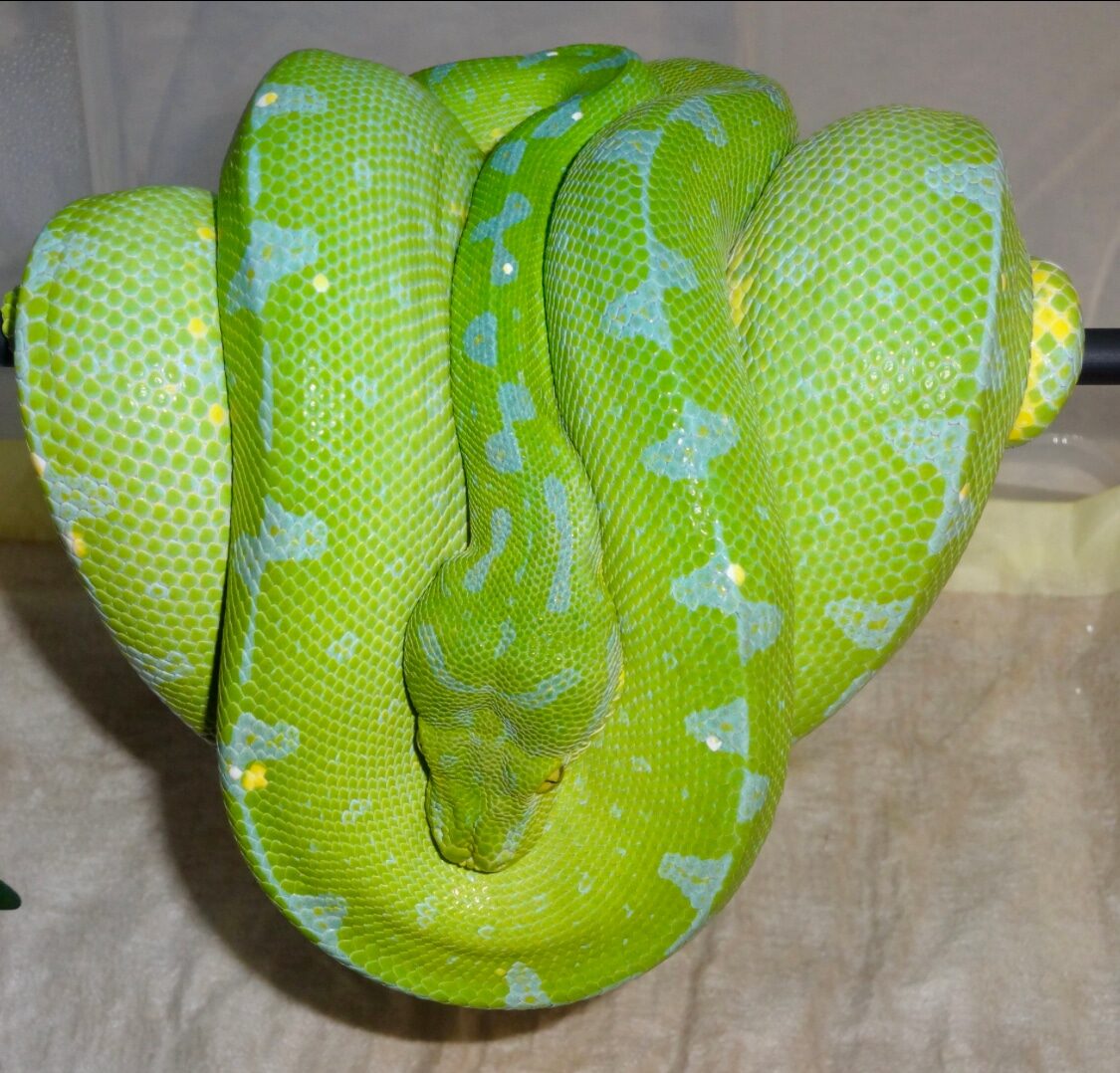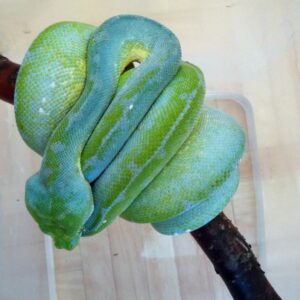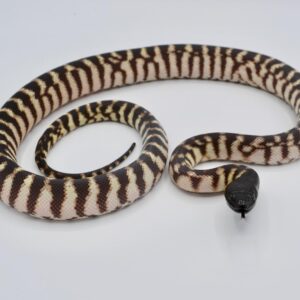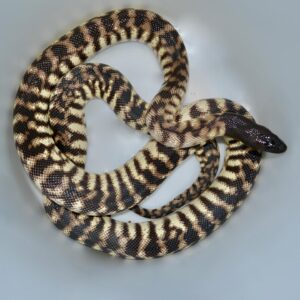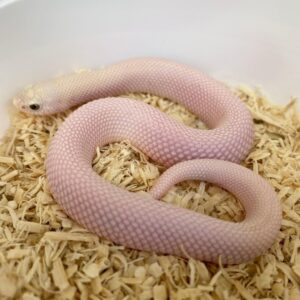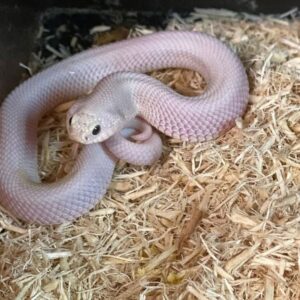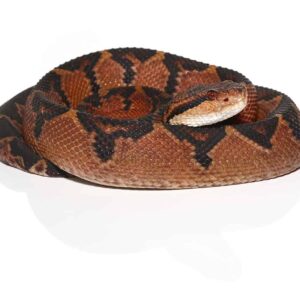Jayapura Green Tree Python For Sale
$625.00
Jayapura Green Tree Python
The JAYAPURA GREEN TREE PHYTHON
Jayapura Green Tree Python are found in the region around the city of Jayapura located situated on the northern shores from Papua, Indonesia, and extend to the adjacent regions like Lereh, Cyclops Mountain, and Arso.
It is possible that many imported chondros labelled as Jayapura may be actually from one of the nearby regions. This makes Jayapura extremely difficult to differentiate from neighboring regions especially with neonates that are yellow.
Jayapura Green Tree Python from Jayapura are able to be seen in a range of phenotypic forms that are typical of northern mainland Morelia Azureus.
They are either yellow or red in neonates, and are mostly taken in yellow. Many scientists have speculated that red neonates are typically found in higher elevations and because the Jayapura region itself isn’t so mountainous as the neighboring regions, the higher proportion of yellow neonates is a proof of this hypothesis.
Jayapura Green Tree Python eat small mammals and other reptiles, such as frogs, birds, lizards, and bats, especially those found in trees. They are also known to eat ground-dwelling rodents. They use their sense of smell to locate prey and are excellent climbers. As juveniles, they are diurnal and more active during the day. They are obligate ambush predators and will lure prey close by wiggling the tip of their tail, mimicking a worm, before striking and constricting their prey. When kept as pets, they are often fed a diet that primarily consists of rats and mice
Description
The Jayapura Green Tree Python (Morelia viridis) is a captivating species renowned for its striking appearance and serene demeanor, making it highly coveted among reptile enthusiasts worldwide. This python is distinguished by its vivid green coloration, a trait that is particularly prominent in specimens originating from the Jayapura region of Papua New Guinea. The lush, emerald hue of its scales not only provides it with excellent camouflage within its natural rainforest habitat but also contributes significantly to its allure in the exotic pet trade.
Scientifically classified under the family Pythonidae, the Jayapura Green Tree Python is known by various common names, including the New Guinea Green Python and the Emerald Python. These names reflect its geographical origins and its remarkable green coloration, which can vary slightly depending on the individual and its environment. In addition to its striking green scales, juveniles of this species often display a vibrant yellow or red coloration, which gradually transitions into the characteristic green as they mature, a process that captivates both researchers and hobbyists.
The importance of the Jayapura Green Tree Python in the exotic pet market cannot be understated. Its calm disposition and relatively manageable size make it an ideal candidate for captivity, where it can be observed and appreciated up close. However, the species’ popularity also underscores the need for responsible breeding and trade practices to ensure its conservation and sustainability. Enthusiasts and breeders alike are drawn to this python not only for its beauty but also for its relatively straightforward care requirements, which, when met, allow the snake to thrive in a captive environment.
Overall, the Jayapura Green Tree Python is a species that embodies both natural elegance and the intricate balance of biodiversity within its native range. Its enchanting appearance and gentle nature continue to inspire awe and fascination among those who have the privilege of encountering it, whether in the wild or as part of a carefully maintained collection.
Habitat and Natural Environment
The Jayapura Green Tree Python, scientifically known as Morelia viridis, thrives in the dense tropical rainforests of Papua New Guinea. This region provides an ideal habitat characterized by high humidity, substantial rainfall, and consistently warm temperatures. The lush vegetation forms a verdant canopy, creating an intricate arboreal ecosystem where the Jayapura Green Tree Python has evolved to flourish.
The tree canopies play a pivotal role in the life of the Jayapura Green Tree Python. These snakes are highly arboreal, spending a significant portion of their lives suspended among the branches. The dense foliage offers ample cover from predators and a strategic vantage point for ambushing prey. The python’s vibrant green coloration provides excellent camouflage against the backdrop of leaves, enhancing its ability to remain undetected.
In this ecological niche, the Jayapura Green Tree Python exhibits remarkable adaptations. Its prehensile tail aids in navigating the treetops, allowing it to grasp branches securely. Additionally, its slender, elongated body facilitates movement through the dense forest canopy. These physical adaptations are complemented by behavioral traits, such as nocturnal hunting, which reduces competition and predation risks.
Regarding diet, the Jayapura Green Tree Python primarily preys on small mammals, birds, and occasionally reptiles. The rich biodiversity of Papua New Guinea’s rainforests ensures a steady supply of prey, supporting the python’s nutritional needs. The python employs a sit-and-wait strategy, remaining motionless and striking swiftly when an unsuspecting prey ventures too close.
While the Jayapura Green Tree Python is adept at avoiding predators, it is not entirely free from threats. Natural predators include larger birds of prey and some arboreal mammals. These threats, however, are mitigated by the python’s exceptional camouflage and arboreal agility.
In summary, the tropical rainforests of Papua New Guinea provide an optimal environment for the Jayapura Green Tree Python. The canopy’s complexity and the region’s climatic conditions foster a habitat where this species can thrive, showcasing its unique adaptations and ecological significance.
Physical Characteristics
The Jayapura Green Tree Python, scientifically known as Morelia viridis, is renowned for its striking physical features, making it a subject of fascination among herpetologists and reptile enthusiasts alike. One of the most notable aspects of this species is its vibrant green scales, which serve as an effective camouflage in its natural habitat of dense, tropical rainforests. This vivid coloration is occasionally accentuated by blue or white markings, adding to the snake’s visually captivating appearance.
Typically, an adult Jayapura Green Tree Python measures between 4 to 6 feet in length, with some individuals reaching up to 7 feet. Despite their considerable length, these pythons are relatively lightweight, usually weighing between 2 to 5 pounds. Their slender, muscular build is perfectly adapted for a life spent predominantly in the trees. The snake’s body is structured to be both powerful and agile, allowing it to navigate the arboreal environment with ease.
A distinctive feature of the Jayapura Green Tree Python is its prehensile tail. This tail is not only a physical characteristic but also a crucial tool for survival. It acts as an anchor, enabling the python to maintain stability and balance while climbing. Additionally, the prehensile tail is instrumental during hunting, as it allows the python to secure itself to branches while striking at prey with precision. This unique adaptation underscores the species’ specialized evolution for a tree-dwelling lifestyle.
Overall, the physical characteristics of the Jayapura Green Tree Python are a testament to its adaptation to life in the canopy. Its vibrant coloration, slender build, and prehensile tail all contribute to its efficiency as both a predator and an arboreal inhabitant, making it a truly fascinating species within the reptile kingdom.
Behavior and Temperament
The Jayapura Green Tree Python is a nocturnal predator that showcases a fascinating array of behaviors. These snakes are predominantly arboreal, spending the majority of their time coiled among the branches of trees. This arboreal nature allows them to exploit their environment effectively, utilizing their prehensile tails to maintain balance and navigate through the canopy with ease. Their nocturnal hunting habits are particularly interesting; they use their keen sense of smell and heat-sensing pits to locate prey such as small mammals, birds, and reptiles during the night.
In the wild, the Jayapura Green Tree Python exhibits a unique hunting posture known as the “S-curve.” When poised for an ambush, the snake coils its body into an S-shape, allowing it to launch a rapid strike at unsuspecting prey. This behavior is a testament to their adaptability and efficiency as predators. Additionally, these pythons are known for their vibrant coloration, which ranges from bright greens to yellows and blues, providing excellent camouflage among the dense foliage of their native habitats.
When it comes to their temperament in captivity, the Jayapura Green Tree Python can vary. While some individuals may exhibit a more docile nature, others can be quite defensive, especially when they feel threatened. Handling these pythons requires patience and experience, as improper handling can lead to stress for the animal and potential injury for the handler. It is essential to approach them calmly and confidently, allowing the snake to become accustomed to human interaction over time.
Moreover, providing an appropriate environment is crucial for maintaining their well-being in captivity. A well-ventilated enclosure with ample vertical space, branches for climbing, and a controlled temperature and humidity level can help reduce stress and promote natural behaviors. By understanding and respecting the behavior and temperament of the Jayapura Green Tree Python, enthusiasts can ensure a harmonious and enriching experience for both the snake and its keeper.
Diet and Feeding Habits
The Jayapura Green Tree Python, a remarkable species native to the rainforests of New Guinea, has a diverse diet that plays a crucial role in its survival and overall health. In the wild, these arboreal snakes primarily feed on a variety of small mammals, such as rodents, which constitute a significant portion of their diet. Birds also form an essential part of their nutritional intake, with the python often utilizing its keen sense of smell and excellent camouflage to ambush avian prey. Occasionally, they may consume smaller reptiles, although this is less common.
When it comes to captivity, maintaining a diet that closely mimics their natural feeding habits is vital for the health and well-being of the Jayapura Green Tree Python. In a controlled environment, these pythons are typically fed pre-killed rodents, such as mice or rats, which are readily available and provide a balanced nutritional profile. The frequency of feeding depends on the age and size of the python. Juveniles generally require feeding every 5 to 7 days due to their faster metabolism and growth needs. Adult pythons, on the other hand, can be fed every 10 to 14 days, as their metabolic rate slows down with maturity.
Adapting the feeding schedule to the python’s natural habits can help reduce stress and encourage a more natural feeding response. It is important to ensure that the prey size is appropriate for the python, typically no larger than the thickest part of the snake’s body, to prevent any potential health issues such as regurgitation or digestive problems. By closely mimicking the Jayapura Green Tree Python’s natural diet and feeding habits, keepers can promote a healthier, more active, and stress-free lifestyle for these captivating reptiles.
Reproduction and Lifespan
The reproductive cycle of the Jayapura Green Tree Python is both intricate and fascinating. Breeding typically occurs during the rainy season, from November to March. During this period, males engage in competitive behaviors, often wrestling with one another to win the favor of a receptive female. Successful mating can be observed through a process of the male entwining his body around the female, a behavior that may last several hours.
Once mating is successful, the female Jayapura Green Tree Python will undergo a gestation period that lasts approximately 45 to 55 days. Following this, she will lay a clutch of eggs, typically ranging from 6 to 30, depending on her size and health. These eggs are carefully incubated by the female, who will coil around them to regulate their temperature. The incubation period for the eggs is around 50 to 65 days, at which point the hatchlings emerge. These young pythons are initially red or yellow, only acquiring their characteristic green coloration as they mature.
The lifespan of the Jayapura Green Tree Python varies significantly between the wild and captivity. In their natural habitat, these pythons face numerous challenges such as predation and environmental stresses, which can limit their lifespan to around 10 to 15 years. Conversely, in captivity, where they benefit from consistent food supply, veterinary care, and a controlled environment, they can live significantly longer, often reaching up to 20 years or more. Proper husbandry practices are crucial to ensuring their longevity, underscoring the importance of knowledgeable and committed care for these captivating reptiles.
Understanding the reproductive cycle and lifespan of the Jayapura Green Tree Python not only provides insights into their biology but also highlights the complexity and beauty of these remarkable creatures. It emphasizes the need for continued research and conservation efforts to preserve their populations both in the wild and in captivity.
Conservation Status and Threats
The Jayapura Green Tree Python, a visually stunning species native to the rainforests of New Guinea, faces several conservation challenges. Classified under the IUCN Red List as “Least Concern,” this designation may seem reassuring. However, the survival of the Jayapura Green Tree Python is far from guaranteed, as their natural habitat is increasingly threatened by human activities and environmental changes.
One of the primary threats to the Jayapura Green Tree Python is deforestation. Extensive logging operations, driven by commercial interests, have led to significant habitat loss. The rainforests where these pythons thrive are being cleared for timber and agricultural expansion, which severely impacts their living environment. As trees are felled, the microhabitats essential for their survival and reproduction are destroyed, leading to population declines.
Climate change also poses a significant threat to the Jayapura Green Tree Python. Alterations in temperature and precipitation patterns can disrupt the ecological balance of their rainforest habitats. These changes can affect the availability of prey and suitable nesting sites, further stressing an already vulnerable species. Additionally, more frequent and severe weather events, such as cyclones and floods, can lead to habitat degradation and population fragmentation.
Despite these challenges, there are ongoing conservation efforts aimed at protecting the Jayapura Green Tree Python. Local initiatives focus on preserving crucial habitats through the establishment of protected areas and sustainable land-use practices. International collaboration is also essential, with various organizations working together to raise awareness and promote conservation strategies. Efforts include habitat restoration projects, anti-poaching measures, and community engagement programs to foster coexistence between humans and wildlife.
Moreover, research and monitoring programs are vital to understanding the population dynamics and ecological needs of the Jayapura Green Tree Python. By collecting data on their distribution, behavior, and genetics, conservationists can develop more effective strategies to ensure the long-term survival of this remarkable species.
Caring for a Jayapura Green Tree Python in Captivity
Properly caring for a Jayapura Green Tree Python in captivity requires meticulous attention to detail, ensuring that its environment mimics its natural habitat. The enclosure setup is paramount to the python’s health and well-being. A vertically oriented terrarium is ideal, providing sufficient height for climbing, as these pythons are arboreal by nature. The minimum recommended size for an adult is 24x24x36 inches.
Temperature and humidity are critical components of the python’s enclosure. The ambient temperature should be maintained between 75-85°F, with a basking spot reaching up to 90°F. Nighttime temperatures can safely drop to around 70-75°F. Humidity levels should be kept between 50-70%, emulating the moist conditions of their natural rainforest habitat. Regular misting and the use of a hygrometer to monitor humidity are advised.
Climbing structures are essential for the Jayapura Green Tree Python. Branches, vines, and perches must be securely installed to allow the python to exhibit natural behaviors. Providing various diameters and orientations of climbing structures helps in stimulating the python and preventing stress.
Health care for a Jayapura Green Tree Python involves regular observation and maintenance. Common ailments include respiratory infections, parasitic infestations, and skin issues such as retained shed. Ensuring proper humidity and temperature can prevent many of these issues. Regular veterinary check-ups and fecal exams are recommended to catch potential health problems early.
Feeding should be done with appropriately sized prey, typically mice or rats, every 7-10 days for adults. Fresh water should always be available, and the enclosure should be cleaned regularly to maintain hygiene. By providing a well-maintained environment and attentive care, a Jayapura Green Tree Python can thrive in captivity, offering a fascinating glimpse into the world of these striking reptiles.


